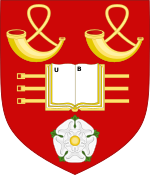St Patrick's Church, Bradford
19th-century Roman Catholic church buildings in the United KingdomBuildings and structures in BradfordCommons category link is locally definedFranciscan Friars of the RenewalGeorge Goldie church buildings ... and 7 more
Gothic Revival architecture in West YorkshireGothic Revival church buildings in EnglandGrade II listed Roman Catholic churches in EnglandGrade II listed churches in West YorkshireRoman Catholic Diocese of LeedsRoman Catholic churches completed in 1853Roman Catholic churches in West Yorkshire

St Patrick's Church is a Roman Catholic church in Bradford, West Yorkshire, England. It was built from 1852 to 1853 and designed by George Goldie. It is situated on the corner of Sedgfield Terrace and Westgate in the city centre. To the south and west of the church is Rebecca Street and Vaughan Street. The church is the oldest Roman Catholic church still in use in the city and is a Grade II listed building.
Excerpt from the Wikipedia article St Patrick's Church, Bradford (License: CC BY-SA 3.0, Authors, Images).St Patrick's Church, Bradford
Sedgfield Terrace, Bradford Manningham
Geographical coordinates (GPS) Address External links Nearby Places Show on map
Geographical coordinates (GPS)
| Latitude | Longitude |
|---|---|
| N 53.7975 ° | E -1.7629 ° |
Address
St Patrick's church
Sedgfield Terrace
BD1 2RU Bradford, Manningham
England, United Kingdom
Open on Google Maps










